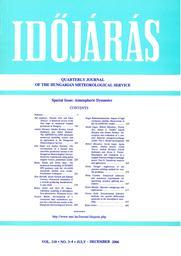IDŐJÁRÁS - angol nyelvű folyóirat
Vol. 110, No. 3-4 * Pages 193–445 * July - December 2006
 |
|
 letöltés [pdf: 107955 KB]
letöltés [pdf: 107955 KB]
A historical review of the first steps in numerical weather prediction in Hungary
Ambrózy Pál, Götz Gusztáv, Tänczer Tibor
idojaras.2006.3-4.1 (p. 193–)
Ambrózy Pál, Götz Gusztáv, Tänczer Tibor
idojaras.2006.3-4.1 (p. 193–)
The ARPEGE/ALADIN mesoscale numerical modeling system and its application at the Hungarian Meteorological Service
Horányi András, Kertész Sándor, Kullmann László, Radnóti Gábor
idojaras.2006.3-4.2 (p. 203–)
Horányi András, Kertész Sándor, Kullmann László, Radnóti Gábor
idojaras.2006.3-4.2 (p. 203–)
The development of a limited area ensemble prediction system at the Hungarian Meteorological Service: sensitivity experiments using global singular vectors, preliminary results
Hágel Edit, Horányi András
idojaras.2006.3-4.3 (p. 229–)
Hágel Edit, Horányi András
idojaras.2006.3-4.3 (p. 229–)
The dynamical downscaling of ECMWF EPS products with the ALADIN mesoscale limited area model: preliminary evaluation
Szintai Balázs, Ihász István
idojaras.2006.3-4.4 (p. 253–)
Szintai Balázs, Ihász István
idojaras.2006.3-4.4 (p. 253–)
Numerical simulation of a tornado producing thunderstorm: A case study
Horváth Ákos, Geresdi István, Csirmaz Kálmán
idojaras.2006.3-4.5 (p. 279–)
Horváth Ákos, Geresdi István, Csirmaz Kálmán
idojaras.2006.3-4.5 (p. 279–)
Laboratory modeling of atmospheric flow phenomena: Mountain waves
Gyüre Balázs, Jánosi Imre M.
idojaras.2006.3-4.6 (p. 299–)
Gyüre Balázs, Jánosi Imre M.
idojaras.2006.3-4.6 (p. 299–)
Development of a variational data assimilation system for a limited area model at the Hungarian Meteorological Service
Bölöni Gergely
idojaras.2006.3-4.7 (p. 309–)
Bölöni Gergely
idojaras.2006.3-4.7 (p. 309–)
Impact of high resolution satellite observations in the ALADIN/HU model
Randriamampianina Roger
idojaras.2006.3-4.8 (p. 329–)
Randriamampianina Roger
idojaras.2006.3-4.8 (p. 329–)
Description and evaluation of a coupled Eulerian transport-exchange model Part I. Model development
Lagzi István; Mészáros Róbert; Ács Ferenc; Tomlin, A.S.; Haszpra László; Turányi Tamás
idojaras.2006.3-4.9 (p. 349–)
Lagzi István; Mészáros Róbert; Ács Ferenc; Tomlin, A.S.; Haszpra László; Turányi Tamás
idojaras.2006.3-4.9 (p. 349–)
Description and evaluation of a coupled Eulerian transport-exchange model Part II. Sensitivity analysis and application
Mészáros Róbert, Lagzi István, Juhász Ágota, Szinyei Dalma, Vincze Csilla, Horányi András, Kullmann László, Tomlin, A.S.
idojaras.2006.3-4.10 (p. 365–)
Mészáros Róbert, Lagzi István, Juhász Ágota, Szinyei Dalma, Vincze Csilla, Horányi András, Kullmann László, Tomlin, A.S.
idojaras.2006.3-4.10 (p. 365–)
Application of the operator splitting method for real-life problems
Faragó István
idojaras.2006.3-4.11 (p. 379–)
Faragó István
idojaras.2006.3-4.11 (p. 379–)
Analytical solutions and numerical experiments for optimizing operator splitting procedures
Csomós Petra
idojaras.2006.3-4.12 (p. 397–)
Csomós Petra
idojaras.2006.3-4.12 (p. 397–)
Operator semigroups and applications
Sikolya Eszter
idojaras.2006.3-4.13 (p. 417–)
Sikolya Eszter
idojaras.2006.3-4.13 (p. 417–)
Discontinuous Galerkin methods for partial differential equations in the atmospheric modeling
Izsák Ferenc
idojaras.2006.3-4.14 (p. 427–)
Izsák Ferenc
idojaras.2006.3-4.14 (p. 427–)
IDŐJÁRÁS folyóirat

Az IDŐJÁRÁS a HungaroMet Nonprofit Zrt. negyedévenként megjelenő angol nyelvű folyóirata
Megrendelhető a journal.idojaras@met.hu címen.
A szerzőknek szánt útmutató itt olvasható.
Megrendelhető a journal.idojaras@met.hu címen.
A szerzőknek szánt útmutató itt olvasható.









